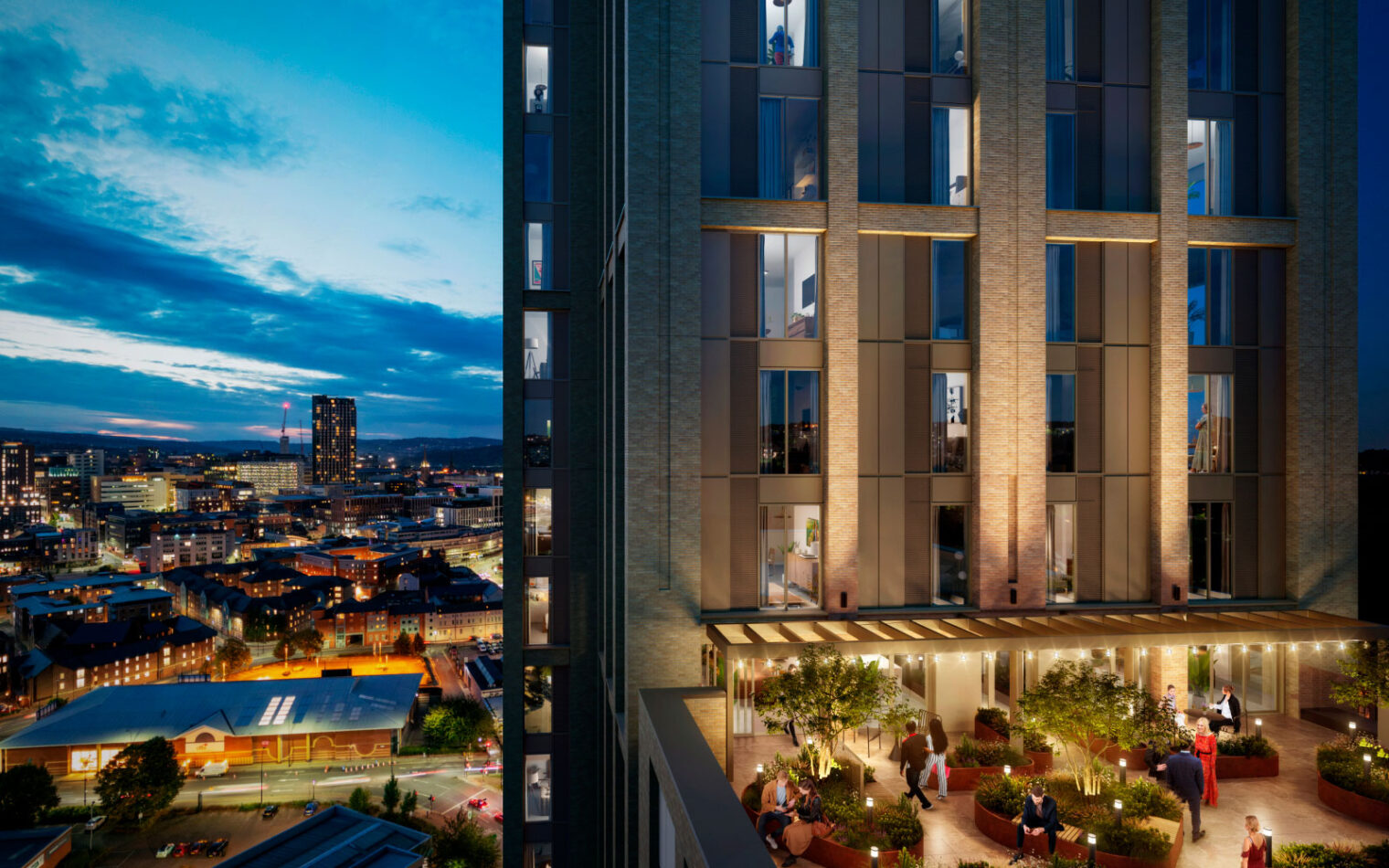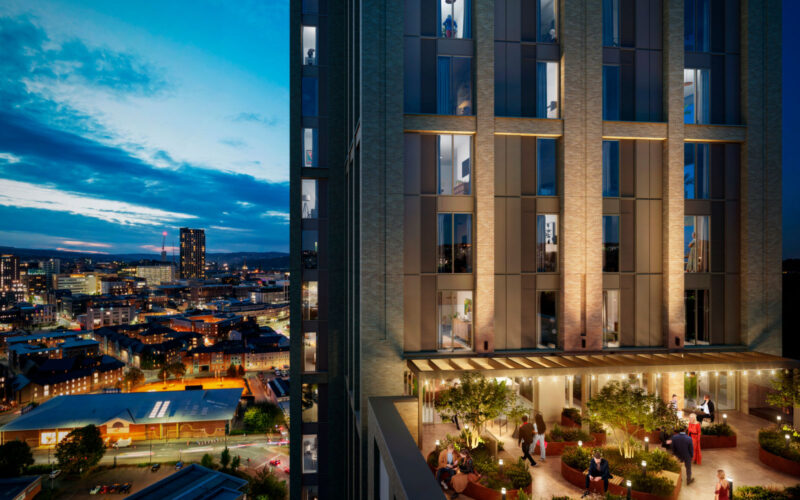Green Street News: Europe Q+A: Bluecastle CEO on launching a £500m build-to-rent fundraise
Bluecastle isn’t short of ambition. It recently snapped up a site in Birmingham city centre for development into a 50-storey build-to-rent tower.
A 1,800-home pipeline across plots in Cardiff, Sheffield, Stevenage and now Birmingham is no small achievement – even more so considering that Bluecastle takes the unusual approach of using absolutely no debt.
After working with investors to support early-stage investment, Bluecastle is now fundraising for its first institutionally targeted fund, aiming to complete a first close of £500m by the end of this year with further vintages to follow.
Green Street News spoke with Ed Williams, founder and chief executive, on moving into institutional fundraising, and why Bluecastle will never use debt.
What’s the potted history of Bluecastle, and why did you choose to focus on build-to-rent (BTR)?
We were set up in 2015. I’d been involved with commercial real estate for, well, more than 20 years, and the reason for setting up Bluecastle was really to get involved in the living sector.
I cut my teeth really investing in and venturing with small- to medium-sized housebuilders. Then we came across the concept of BTR, and for the past four years we decided to completely throw everything in and focus 100% on BTR.
There’s a perfect storm at the moment. BTR has a confluence of trends that makes you just know it’s going to be a mega-trend. We geared the whole business up to take advantage of that.
“We decided we would take a completely integrated approach and start with development, because that’s the rare commodity”
Our DNA is that of an investment firm. We are first and foremost investors, asset managers, fund managers. But if you just bring capital to this sector, I think that’s a bit of a mistake. If anything, there seems to be quite a big queue of capital that’s looking for sterling and inflation-linked returns, and then to get outperformance over those, which obviously BTR delivers.
But what’s in short supply are really good deals, good sites that are well located, that have the right level of scale. We decided we would take a completely integrated approach and start with development, because that’s the rare commodity.
The traditional approach for asset allocation is to set up a fund, identify transactions in the commercial real estate sector, and then deploy the capital. But unfortunately we think that’s the wrong way around. We set up to establish our own development arm four years ago, and we set up our own FCA-regulated platform that we use to raise capital from very high-net-worth, small family offices.
Why set up your own fundraising platform?
The intention of that was to give us entrepreneurial capital that gives us the opportunity to acquire sites outright. We don’t use debt. One of our principles as a business is – and this is bad news for all the lenders out there – we just don’t believe in debt. I’ve got too many scars, too many grey hairs to want to employ debt.
If you actually take debt out of the equation, the equity slice becomes much more attractive from a risk-adjusted return perspective. Clearly the returns are lower in the upside scenario, but there is a huge level of downside protection and you have control over the timelines, which of course in development you’re never in control of.
We decided to raise all of our capital initially in the form of equity, to acquire sites outright. We want to have total control and we don’t want to be in a joint venture with somebody else who wants to have an equal level of control. We acquire sites and we develop them ourselves all the way through to long-term operation.
We’re not just developers – we’re also going to be asset managers and fund managers, and we’re going to be operating these schemes ourselves. I think in the UK BTR space, we are relatively unique, in that we are taking a cradle-to-grave, fully integrated approach.
There’s quite a lot of people in the development space that then exit. There’s a number that are in the operating-only space, which I think is challenging as a business model. But there’s very few that are seeking to bring all of those activities in-house under one roof, which is what we’ve done.
Why do you avoid debt as a strategy?
I take the personal view that if you use debt at any stage of an asset’s life cycle, you are by definition handing control over to a lender. Because under certain circumstances they have control, otherwise they would never lend you the money. As a philosophical principle, I take the view that if I’m acting on behalf of my investors and I’m the custodian of their capital, I’ve got a fiduciary duty to put their interests first.
“I’ve got too many scars, too many grey hairs, to want to employ debt”
How can I in good faith hand over control to a third party? It just flies in the face of being an investor and protecting your investors’ money.
We’re currently raising a new fund to take the assets through to completion, and have already raised up to £75m to support the early-stage development. A significant portion of that capital has now been deployed across our four sites.
What are your current plans for fundraising for different parts of the development cycle?
Our investment vehicles can take a project all the way from forward funding through to 80 years of ownership.
You’ve got to have a vehicle that can offer investors access on those timeframes. We broadly think there are two classes of investors in the institutional space. On one hand, there are those that are looking for more private equity-style returns, which on an unlevered basis would be double digits – 10% to 15%. On the other hand, you’ve got very risk-averse investors that only want stabilised assets.
If you really want optimal assets, you’ve got to be investing at the forward-funding stage at the moment. You cannot be investing in stabilised assets, because they’re too small and they’re very rarely compliant.
We’ve got two routes that investors can come in. One is they can come in for that intermediate stage and get the high returns, or they can use that as a means to gain essentially discounted long-term ownership.
Why are you fundraising for an institutional vehicle now?
At present, major institutions are undertaking their own forward fundings out of necessity. That’s largely because there’s no credible indirect vehicle in the market with the scale, governance and alignment they require.
Over the next five to 10 years, we believe these groups will increasingly recognise that partnering through a dedicated, scaled platform is a more efficient and effective way to allocate capital to the sector.
We’re aiming to create an indirect vehicle, which will mean that those investors that do understand forward-funding risk as a means of gaining long-term ownership will have a real indirect alternative. That’s why we’ve structured our fund to facilitate medium-term ownership as well as long-term. We don’t have the stabilised fund yet.
“It’s quite likely that we will first have an initial capital raise for our institutional fund of £500m by the end of this year”
An important distinction, which has taken us four years to gain as an asset manager – so not easily won – is a seed portfolio. One of the big problems in this space at the moment is it’s very easy to secure capital commitments, particularly if you have a huge balance sheet or a lot of people employed in your organisation. But actually it’s the deals that matter.
We’ve got 1,800 units within our portfolio, including Birmingham. The total of all of those would be about £800m of GDV. It’s quite possible that the first batch of those is likely to be the first three deals, as Birmingham’s going to be some time away. It’s quite likely that we will first have an initial capital raise for our institutional fund of £500m by the end of this year. We will have subsequent vintages on a regular basis.
Bluecastle is very regional in terms of your assets. What’s the strategy behind that?
We map every city we’re interested in. But before we do the mapping, we decide which cities actually stack up. You’ve got very fundamental drivers around availability of rent or stock. You’ve got levels of rent, which are always a really good indicator of whether a site is going to work or not, because capital values and build costs do vary, and you have different yields in different locations. Rents are one of the biggest determinants of whether a site or a location is going to work.
But when you look at the rents, you need to look at the level of affordability and the types of people that live there, which brings you to employment. You have to build a data map, and then you have to set it to one side and then look at the anecdotal evidence in a location, and see how many people, for example, are leaving university, and staying on in that location, which is particularly high in places like Sheffield.
We look for levels of regeneration. We look for levels of proactivity among the planning departments and among the regeneration teams. We engage with them really early on. We look at what they’re doing, and what regeneration they’ve already achieved.
“I’m more interested in fundamentals than froth”
If you look at Stevenage and Sheffield, one of the big themes of those two locations is the success with which they’ve already regenerated the town centres, and their ambition to push that forward.
Quite separately, they’ve got amazing underpinning fundamentals. You’ve got relatively low levels of rent in Stevenage – much lower than for example in Wembley, where eight years ago you wouldn’t have considered wanting to rent a BTR property there perhaps. Stevenage is extremely well connected, being only 25 minutes from central London. But it’s also the biggest bioscience hub in Europe.
Others were completely dismissing it two or three years ago when we first identified our site. But I’m more interested in fundamentals than froth.
Are you intending to become an operator of greater scale?
We don’t just want to do one scheme in each location. Our strategy is really to become the dominant force in the fully integrated indirect investment space of BTR.
The winners in this space are going to have scale. The big thing that’s changed in the valuation space for BTR has been operating cost assumptions. Crazily, everyone assumed 25% is what you lose between your gross rent and your net operating costs. In fact, it varies hugely across schemes. We’ve spoken to some of the biggest operators, and they’ve quoted us somewhere around 18% to 40%.
A theme that’s coming from the valuers is they will no longer value a stabilised asset with a standardised operating cost. They’re looking underneath the model at what level of rent you are achieving, with what resource and at what cost, and they will price the asset accordingly.
You can make more of an impact on the capital value of your assets by being efficient and effective at how you operate them, than you can with the number of units, or just the level of rent that you achieve.
“You can’t do this as a small player anymore. The minimum capital allocation per deal is £120m to £200m”
It’s born out in the stats. If you look at what’s currently built, the average number of units is 150. If you look at the number of units that are under construction at the moment, it’s about 200. So if you look at the ones that are just coming through planning, which is around 100,000 units, 285 is now the average size.
You can’t do this as a small player anymore. The minimum capital allocation per deal is £120m to £200m. You really need a lot of scale to be in this space, and if you’re not doing it on an integrated basis, it really isn’t going to be a joined-up scheme.
What’s your next stage of growth in the sector?
We’re constantly adding to our development portfolio – we intend to add two to three new assets to the pipeline every year. We intend to bring those forward to construction on a continuous basis.
Our goal is unlimited in terms of the scale of the opportunity. One of the amazing things about BTR is it’s just a sheer imbalance. There’s a million rental properties needed in the next six years or so.
When you look at some of the research on the different cities, such as the fundamental medium-term demand in Leeds, it’s massively outstripping supply. All that’s happened is there’s just been a few buses arriving at once, so there’s some short-term competition. As soon as that absorption is out of the way, you’re back to the same problem. It’s a tiny amount of supply and a massive deficit that keeps growing every year.
Q+A: Bluecastle CEO on launching a £500m build-to-rent fundraise – Green Street News







